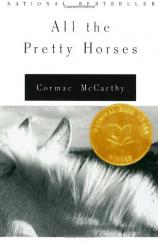All the Pretty Horses
Review
All the Pretty Horses
Just as jazz is the archetypal American music, so is the Western the truly original genre of American literature. The West --- particularly for those of us who grew up on a video diet of television shows such as "Gunsmoke," "Cheyenne," and "The Rifleman," and the literary feast of the classic novels of Zane Gray and Louis L' Amour --- is evocative of a time of rough nobility, where it seemed as if each breath brought a new confrontation of Good vs. Evil. The reality was, of course, something quite different, an existential setting where life and death did strange dances in the sunset and actions occurred with a randomness and happenstance that took no notice of pureness of heart or motive and often rendered foresight useless.
This reality is presented with an indescribable elegance in ALL THE PRETTY HORSES, the first volume of Cormac McCarthy's Border Trilogy. The volumes that comprise The Border Trilogy --- ALL THE PRETTY HORSES, THE CROSSING, and CITIES OF THE PLAIN --- each stand quite well independently, though they are best read together and in order. But it is ALL THE PRETTY HORSES that is, in many ways, the superior volume to its brothers in the trilogy and quite possibly to any other work written by an American writer in the 20th Century.
McCarthy's landscape is the southwest of Texas and Mexico between the two world wars, a time of uneasy transition, when horses and motor vehicles share the road and cattle ranches and cowboys are fading from the landscape. John Grady Cole, a 16-year-old with a love for horses and a knowledge of them far beyond his years, senses on some level that the way of life he loves --- horses and cattle ranching --- is soon to come to an end. He and his best friend Lacey Rawlins run away to Mexico in search of unnamed fulfillment other than the promise of adventure. Their meeting with the enigmatic Jimmy Blevins is a pivotal event that leads Cole into a series of bittersweet and violent encounters in a land where the rules are unknown and constantly changing. When Cole and Rawlins separate from Blevins and obtain employment on a Mexican cattle ranch, it appears that they have achieved their idyllic dream. Their brief association with Blevins, however, collides with Cole's affair with Alejandra, the beautiful and willful daughter of the owner of the ranch. Cole and Blevins soon find themselves in a situation where neither hope nor mercy exist.
McCarthy's main theme in ALL THE PRETTY HORSES is conflict --- man vs. woman, freedom vs. authority, rich vs. poor --- viewed through a clear glass with unblinking, unwavering vision and described with a poetic voice possibly unequaled in all of American fiction. Although the violence in ALL THE PRETTY HORSES is sudden and uncompromising, it is never gratuitous. It is also balanced and contrasted by McCarthy's description of the blossoming and fulfillment of the romance between the star-crossed Alejandra and Cole, a description that leaves the reader hoping that it will succeed even as it is known, almost from their first encounter, that any relationship between them is predestined to fail.
Ultimately, however, what is most significant about ALL THE PRETTY HORSES is that McCarthy has transcended the constraints of literature and fashioned a work that functions on an aural and visual level as well as a literary one. It is on that basis that it is possibly the penultimate American work of art of its era. One cannot come away from reading ALL THE PRETTY HORSES without wondering if, at the end of time and all that is, one of the last sounds to be heard will be the turning of the final page of this wonderful, incredible novel.
Reviewed by Joe Hartlaub on June 1, 1993
All the Pretty Horses
- Publication Date: June 29, 1993
- Genres: Fiction
- Paperback: 301 pages
- Publisher: Vintage
- ISBN-10: 0679744398
- ISBN-13: 9780679744399










